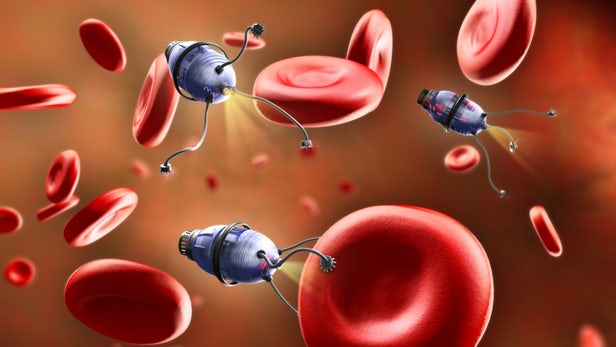
Nanobots – A Gift of Technology and Science
By: Devasena Umai. R | TOC August finalist
How would it be if you have nanobots administered to you, just like how you get vaccinated, and they circulate in your bodies all the time and monitor all that is happening in your body? They can detect any virus or bacteria entering you, before it establishes a disease. They can also deliver drugs and cure the disease! Sounds fascinating?
Technology in science:
Remember the days when we had computers which occupied an entire air conditioned room? They have slowly evolved into different stages to the present day fingertip technologies. Now we have reached the era of Nanotechnology where nanorobotics makes use of technology and medicine to create nanosized robots, called nanobots, which when brought to practical use, would be a great step forward in health care.
Why nanobots?
Just like a handicapped person is supported by robotic prosthetics externally, when nanorobotics, in the form of nanobots is injected internally, it can help overcome our internal handicaps (diseases). Nanobots do the job of a computer antivirus! They can detect antigens, give us an idea of the onset of a disease, they can target and deliver drugs and can also help in non invasive surgeries as well. Humans could become cyborgs with the ability to prevent and overcome diseases easily.
Construction and functioning:
Nanobots can be built by applying DNA origami techniques. These nanobots, having a clamshell shape can be programmed to detect infected cells (such as cancer cells) and deliver drugs specifically to those cells alone and destroy them, without affecting the other healthy cells. This function of nanobots has already been tried and proven to be effective.
So going on to the next level, nanobots could also be constructed in such a way that they can be used to detect any bacteria or virus that enter our body, with the help of the antigen receptors.
Furthermore, they can be made to transmit data from our body. These bots, made up of carbon nano tubes, are so small and can barely carry big modules like a bluetooth or wifi module. But they can be made to carry simple transmitting and receiving modules within their chip. Since these bots are almost organic, they are not electrically controlled or battery controlled. We cannot control their movement but we can only monitor them. In order to transmit the data collected by the bots, they have to either store the information within themselves or transmit them to a cloud. For transmitting data from point to point location they require a certain frequency level of transmission that can affect blood cells. So to rectify this, we can have the bots collect all information, store them and then transmit them, at the end of the day or maybe on a weekly basis, to the app.
So, what happens is, the nanobots keep circulating in the body, they detect any foreign particle or organism, if any, and has the information stored within its data chip in the form of byte code. They transmit the data to the server from where it reaches the app. The app tells us if we have or will have any ailment which can be rectified in the very beginning .If there is any information to be transmitted from the app to the bots, it can be done through the receiver within the bots. The app transmits the command to bots through the receiver.
One day it might also be possible for the nanobots to transmit our thoughts to the cloud. But this needs a lot of advancement in neuroscience and nanorobotics.
Nanobots in surgery:
Mostly we consider that surgeries are the ultimatum for cure but though it is true to some extent, problems recur in some cases, there are side effects, recovery time is long and restrictions are many that affect day to day activities. There is no guarantee of 100% cure and its quite risky most of the time.

When nanobots are used for surgery, the procedure can be done faster ,it is minimally invasive, post operative care is minimal, there is continuous tracking of what is going on inside and so we can get to know if the problem would occur again.
Other implementations of nanobots:
Nanobots can be constructed in the form of tiny capsules with nano sized pores in them. This can be used to deliver insulin. The bots can be programmed to release the required amount of insulin as and when needed and it would be a helpful alternative for the diabetic patients who have to inject insulin daily. Similarly, nanobots can also be made to detect nutrient deficiency in the body and deliver nutrients that the body is deficient of. They can also be used to clear plaques in veins, also repair arteries and clear blood clots.
Advantages of nanobots:
- They can be programmed to act specifically.
- We can expect a fast and effective recovery.
- Many diseases can be prevented and cured with just a shot.
- Using nanobots as an alternate medicine would definitely reduce the side effects.
Disadvantages of nanobots:
- Nanobots might be mistaken by the immune system as some antigen and get eliminated. This could cause adverse side effects on the host. So to solve this issue, we can introduce plasma properties to them to fake them out to the immune system.
- The initial construction cost of the bots is more.
- More understanding, development and advancements should be made in nanorobotics to overcome the present issues concerned with the working of the bots.
Conclusion:
Though it is in its primitive stage, nanobots have already undergone clinical trials and proven to be effective in drug delivery. More developments in nanobots would be a big leap in the medical field. This technical advancement in the field of science will be a boon to mankind.







Leave a Reply